Starlink Kenya: Escape Slow Internet, But at What Cost?
Starlink has become a game-changer in Kenya’s internet landscape, offering high-speed satellite connectivity to areas where traditional broadband services remain limited. Since its launch, the service has drawn attention from individuals, businesses, and institutions looking for reliable connections beyond urban centers. For new users, local partners like Starlink Kenya Installers provide professional setup, ensuring that dishes are mounted and aligned correctly for maximum performance. Additionally, Spacelink Kenya supports customers by making Starlink products and accessories more accessible while offering local expertise and guidance.
The value of Starlink lies in its ability to bypass the limitations of terrestrial networks. While fiber and mobile providers have expanded coverage across Kenya, many rural and remote areas still lack stable internet. By linking users directly to a constellation of satellites, Starlink provides download speeds that rival or exceed some traditional providers. This has proven particularly useful for remote schools, health facilities, and small enterprises that depend on stable internet for essential operations.
One of the biggest barriers to widespread adoption, however, is cost. The equipment package, which includes the satellite dish and router, comes at a significant upfront expense. Subscription plans are also higher than what many households pay for mobile internet or home Wi-Fi, making Starlink more attractive to users who prioritize reliability over price. While equipment rental options have been introduced to lower the initial investment, affordability remains a key consideration for expansion into low-income communities.
Regulation presents another challenge. The Communications Authority of Kenya has been examining how satellite providers like Starlink should operate within the country, including licensing requirements and partnerships with local firms. Established telecoms have raised concerns about competition and compliance, highlighting the need for clear frameworks that balance innovation with fairness in the sector. How regulators address these issues will influence the pace of Starlink’s growth in Kenya.
Despite these challenges, user experiences show that Starlink delivers meaningful benefits. Families in remote areas now have access to online education, telemedicine, and streaming services without interruption. Entrepreneurs are able to run digital businesses, attend virtual meetings, and market products online, even in places where connectivity was once impossible. The low latency offered by Starlink’s low-Earth orbit satellites makes activities like video conferencing and online gaming much more feasible compared to traditional satellite internet.
Looking into the future, the role of local partners and installers will be critical in driving adoption. By making the service easier to access, providing after-sales support, and helping with compliance, they reduce the complexity for new users. At the same time, Starlink must continue to scale its infrastructure, reduce costs, and work within Kenya’s regulatory environment to remain competitive.
In summary, Starlink Kenya is more than just another internet option; it is a transformative solution for communities long excluded from the digital economy. With growing demand, supportive local partners, and the potential for expanded access, Starlink has positioned itself as a key player in bridging Kenya’s digital divide.





